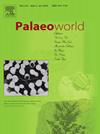深时环境中的壳红藻:来自印度东北部和土耳其的古生态学见解
IF 1.7
3区 地球科学
Q2 PALEONTOLOGY
引用次数: 0
摘要
甲壳红色钙质藻类是全球底栖生态系统中的关键生物,具有造礁和稳定底质等重要功能。从古近纪早期到新近纪,珊瑚藻类与珊瑚和/或大型底栖有孔虫(LBF)一起,作为主要的碳酸盐生产者,在众多浅海哲罗纪碳酸盐平台上繁衍生息。印度东北部梅加拉亚邦 Jaintia 和 Khasi 山的古新世-始新世石灰岩演替包括两种主要群落类型--藻类有孔虫和珊瑚藻,但没有相关的殖珊瑚、而土耳其锡瓦斯盆地和锡尔特省的渐新世-中新世碳酸盐岩的特点是藻类-有孔虫群落,与碳酸盐岩平台环境相关的其他值得注意的成分包括浮游动物、珊瑚和软体动物。我们发现,这些藻类群落的多样性和生态学受到藻类群落的系统结构、沉积物输入、基质稳定性、水深和水动力能量的影响。不同时代和不同地点的藻类群落因沉积机制、环境背景和主要分类群而有所不同。从古新世-始新世温室到渐新世-中新世冰室的气候转变,与之相对应的是由孢藻纲为主的壳藻群到由合生藻纲为主的藻群的转变。本文章由计算机程序翻译,如有差异,请以英文原文为准。
Crustose red algae in deep time environments: Palaeoecological insights from northeastern India and Türkiye (Turkey)
Crustose red calcareous algae are key organisms in benthic ecosystems worldwide with critical functions like reef-building and substrate stabilization. Coralline algae thrived as major carbonate producers, with corals and/or larger benthic foraminifera (LBF) in numerous shallow-marine Tethyan carbonate platforms from the early Palaeogene to the Neogene. The Palaeocene–Eocene limestone successions in the Jaintia and Khasi Hills, Meghalaya, northeastern India, encompass two principal community types — algal-foraminiferal and coralline algal, with no associated colonial corals, while the Oligocene–Miocene carbonates from the Sivas basin and Siirt province in Türkiye are characterized by an algal-foraminifera assemblage with bryozoans, corals, and molluscs as other noteworthy components pertinent to the carbonate platform environment. We found that the diversity and ecology of these algal communities were influenced by systematic structure of the algal assemblage, sediment input, substrate stability, water depth, and hydrodynamic energy. The algal assemblages from different epochs and varying localities diverge based on the sedimentary regime, environmental settings, and the predominant taxa. The climatic transition from the Palaeocene–Eocene greenhouse to the Oligocene–Miocene icehouse corresponded to a shift from crustose algal assemblages dominated by Sporolithales to assemblages dominated by Hapalidiales.
求助全文
通过发布文献求助,成功后即可免费获取论文全文。
去求助
来源期刊

Palaeoworld
PALEONTOLOGY-
CiteScore
4.00
自引率
5.90%
发文量
95
期刊介绍:
Palaeoworld is a peer-reviewed quarterly journal dedicated to the study of past life and its environment. We encourage submission of original manuscripts on all aspects of palaeontology and stratigraphy, comparisons of regional and global data in time and space, and results generated by interdisciplinary investigations in related fields. Some issues will be devoted entirely to a special theme whereas others will be composed of contributed articles. Palaeoworld is dedicated to serving a broad spectrum of geoscientists and palaeobiologists as well as serving as a resource for students in fields as diverse as palaeobiology, evolutionary biology, taxonomy and phylogeny, geobiology, historical geology, and palaeoenvironment.
Palaeoworld publishes original articles in the following areas:
•Phylogeny and taxonomic studies of all fossil groups
•Biostratigraphy, chemostratigraphy, chronostratigraphy
•Palaeoecology, palaeoenvironment and global changes throughout Earth history
•Tempo and mode of biological evolution
•Biological events in Earth history (e.g., extinctions, radiations)
•Ecosystem evolution
•Geobiology and molecular palaeobiology
•Palaeontological and stratigraphic methods
•Interdisciplinary studies focusing on fossils and strata
 求助内容:
求助内容: 应助结果提醒方式:
应助结果提醒方式:


